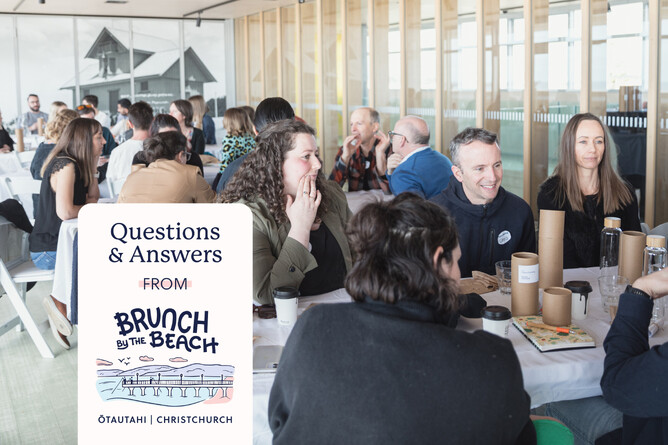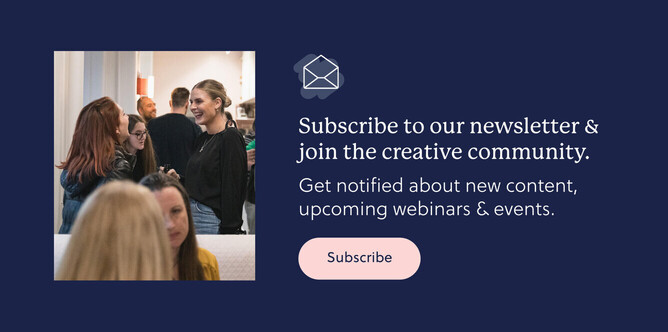Are you struggling with setting the right price for your services? Or perhaps you're unsure about the most effective onboarding process for new clients?
Abby, Nicole, and Serena, are three seasoned entrepreneurs and Graphic Designers. In this Q&A, they share their take on a few elements that are helpful for both budding and established business owners.
What is your onboarding process with new clients?
Abby: “Initial 15 minute consult call to see if they’re a good fit for us - key questions around timeline, budget and ethos. If it’s green flags, full they get a 45min-1hour free consult to get enough info to quote. Then, send scope and quote. Once accepted - sign contract, send deposit invoice etc. Then, into the full discovery meeting and the project!”
Nicole: “I start with a Dubsado lead capture form right from my website contact page, and will not quote or do any business over DM or social media. If they come from Instagram, I’ll direct them to fill out my contact lead form and that’s normally a red/green flag right away if they make the time to fill this in (green flag), or continue to try to engage only on social for a price (red flag). Then if they do fill out my form, they go straight to my Dubsado CRM and are now a potential client/lead in my system. Depending on what they filled out in the form, my system will automatically ping out a specific email right away acknowledging them, thanking them, letting them know I’ll be in touch soon as well as specific information on what they have emailed about (i.e. if it’s branding, the email sends them a welcome guide (things like my contact hours/payment plans/about me etc), current pricing, inclusions, FAQs, a timeline & process breakdown as well as links to some work I’ve done for other branding clients). So while I sleep, I can onboard people and get them familiar with my process right from Day 1.
My system also redirects them to my availability calendar so if they are more into a virtual face-to-face meeting, they have the chance as soon as they submit the contact form, they can set a meeting. I then will email them back in real time and ask a set of saved scoping questions to work out their project needs, and then once they have answered them (and we’ve had a call if they have selected this), I’ll then create a custom proposal outlining the project with all the pricing, process and timeline for the work. If they accept, the proposal workflow (Dubsado again) takes care of the contract, payment and also automatically pings them all the project homework for them to fill out as well as reminds them of the start date and anything else they need to do/complete before we start.”
Serena: “I have a chat with them to find out their challenge/problem, send a quote, send a 50% deposit and sometimes a contract. Then send a questionnaire, then have a meeting to talk through the questionnaire.”
How do I know if I'm charging the right price?
Nicole: “This is a toughie! At a basic level, you need to work out what your outgoings are to live (mortgage/rent, power, internet, groceries etc) then I also look at subscriptions (i.e. Adobe suite, my website/email hosting etc), then I’ll look at what tax/gst I need to cover AND THEN I’ll once I’ve worked out that base rate, I’ll think about what profit will help to keep the business sustainable, enjoyable and worthwhile. I’ll also factor in the expectation level and my audience – who in my dreams I want to work with, and what their expectations/needs/goals/income and then I’ll set everything to align with that. And then project by project, I also work out the value I am bringing to that particular client and ensure I am being compensated by bringing them that value (so my pricing may go up/down based on custom scoping too). Being flexible and also scoping properly helps you to feel confident charging the right price. It can feel really personal/scary to send someone a price for something, so I try to take the emotion out and only look at it from a business perspective – this project will take X amount of time, with X many deliverables, the client will actually bring in X amount from this good design, so my price is X.”
Serena: “I don’t, all I know is that I am living and conversing costs without too much sacrifice.”
Are you charging hourly or as a ‘project package’?
Abby: “Hourly for ongoing contract clients. Project package for projects (these are bespoke). We have indicative ‘packages’ but we custom quote every project.”
Nicole: “Project package for almost everything, but anything out of scope, additional or above and beyond what was originally agreed upon is hourly. So having an hourly rate in mind is important for those situations – what you wouldn’t get out of bed for to work an hour on.”
Serena: “Mostly by package. Small jobs are by the hour.”
What key questions do you ask in the research / on-boarding phase?
Nicole: “I have specific questions depending on what their project is, but these are the ones I send the most for the bigger projects. Branding is a little easier as I have a set package for that, so all I really need to sanity check is if they are confident in knowing who their target audience is.
Details required for website quote:
How many pages will your site need (and what are these pages)
Do you have a current site/what platform are you familiar with?
Do you have your copy ready to go or does this still need to be written. If so, will you be writing it or are you working with a professional copywriter
Do you have your imagery ready to go or does this still need to be taken. If so, will you be sourcing it or are you working with a professional photographer
Does your site require any ecommerce functionality (a shop or products)
Any other special requirements or features you can think of
Do you have a deadline for website launch
Print design:
Number of print items to be designed (and what are they)
Do you need just final PDF files or do you also need the editable templates
Purely print, or for web use too?
Pages/size of each item (i.e Brochure, 8 x A4 pages, Piercing Sheet, 1 x A4 page)
Any specialty printing required (i.e foiling or embossing)
Do you have a printer company in mind or do you still need to sort this part of the process up
Do you have a deadline for any print items
Packaging design:
Will you be providing the product dieline or will this need to be created (example here)
How many different package designs need to be created and how many variations of each (i.e 1 x box design - 3 x size or ingredient variations )
Would your products require any barcodes added (which you'd need to generate and provide)
Are you writing the packaging copy or working with a copywriter (and are you/they handling all the legal stuff like what's required on packaging, use by dates, ingredients, warning label etc)
Will any of your packaging require specialty printing (i.e die cuts, metallic foil, embossing etc)
Do you have a printer company in mind or do you still need to sort this part of the process up
Do you have a deadline for any packaging items
Serena: “What is their challenge/problem? What the key outcome for the project is. What is their goal in 1 year and in 5 years? Do they have a budget and timeline? Who is the main decision maker?”
How do you manage your workload and schedule?
Nicole: “Writing everything down on a big A3 desk pad definitely helps especially if you have multiple projects starting during the months and enquiry calls weekly. Scheduling personal things like the gym or a mental health walk is important too, and make sure to keep like you would a client meeting! The biggest thing that helps me personally is writing out the process and timeline for each packaged project, so I know branding takes exactly X amount of weeks and websites take X amount of weeks. Then each client gets an exact start and end date and we don’t go over there – and if we do, there are always financial or time consequences for the client. This way if my schedule blows out because of the client’s poor time management, I’ll either still get paid on time, fairly compensated for going outside of schedule OR there will be an imposed time delay until they get their design, as I may have started with a new client, so their project will be pushed out until I can work it back into my schedule again.”
How do you keep the work pipeline full?
Nicole: “Marketing your business is a never ending job, so I recommend as soon as you finish a project (and it aligns with your style/was a dream to work on), post about it on social, your website and Pinterest. Purposefully share that work to bring in more work, and I’ve found it directly drives more people to engage. And after you’ve done this, work IN your business if you have a down period. Work on your website, clear out your emails, write some blogs, batch some newsletter musings, make some digital products - and Pin them all too on Pinterest. Though these tasks don’t feel like they will make you money instantly, over time they’ll bring in more clients who will pay for your services after getting caught somewhere in your web of communication.”
Software used to track clients projects ?
Nicole: “Dubsado, all the way! I could speak about this all day and love it so much. It’s like my own personal assistant but with a much smaller salary.”
Does not charging GST hurt your business?
Nicole: “I charge GST on all NZ-based projects, and I made sure to register for GST as soon as I hit the threshold, which was about a year into freelancing. It would have hurt my business initially not charging because at the time I needed to be charging it as I had a contract for design for the local council who needed me to be GST registered before they’d accept my proposal.”
Thanking the incredible Designers that answered these questions for you, our Creative Community.
Abby Marriott - Kōwhai Creative
Serena Mayen - Modern Design
Nicole Macdonald - January Made Design





